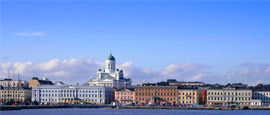Helsinki History
Affectionately known as the 'Daughter of the Baltic', Helsinki sprawls across a low-lying peninsula and is sheltered by an archipelago of 315 islands. Founded by Swedish invaders in 1550, the city is young by European standards, but its power and influence grew dramatically when Russia invaded in 1809.
Under the Swedish King Gustavus Vasa of Sweden, the city grew slowly, although it remained an important military centre for troops and a winter retreat for the navy.
However, Russia's growing dominance in the 18th century and the creation of a new capital, St. Petersburg, not far from the Finnish border, had a major influence on Helsinki. Plague and hunger caused by two separate Russian occupations ensued, so the city constructed the Suomenlinna sea-fortress in 1748.
The Swedes gradually weakened and Finland was finally annexed by Russia as an Autonomous Grand Duchy in 1809. Helsinki was subsequently proclaimed the Finnish capital in 1812 and was rebuilt to match its new status.
Industrialisation, new railways and increasing wealth led to new neoclassical and art deco buildings springing up. The jewel in Helsinki’s art deco crown was its railway station created by Finnish architect Eliel Saarinen.
In 1917 came Finnish independence and another facelift for Helsinki, which boomed throughout the 1920s and 30s. It became a hotbed of creative activity, producing designers such as Alvar Aalto along with the Moomins cartoon, the Nokia company and latterly, Angry Birds. When it stepped onto the world stage with the completion of its Olympic Stadium in 1938, the city gave notice of its new status as the capital of a fiercely independent new country.
Relatively untouched by WWII, Helsinki and Finland emerged from the conflict as an important partner for the West, although its proximity to Russia made the years of the Cold War uneasy ones.
Now part of one of the wealthiest countries in Europe, Helsinki is fast becoming a popular tourist destination and is as famous for its cutting-edge design as it is for its fascinating east-meets-west churches.
Did you know?
• In 1941, The Finnish Foreign Office summoned Tor Borg to the German embassy in Helsinki to question him about his dog Jackie who had been taught to raise her paw when she heard the word ‘Hitler’. No charges were brought.
• During the WWI, the Suomenlinna fortress (then called Viapori) was part of the Naval Fortress of Peter the Great, designed to protect St Petersburg in Russia.
• Helsinki was named World Design Capital in 2012.
Do you have any Feedback about this page?
© 2026 Columbus Travel Media Ltd. All rights reserved. No part of this site may be reproduced without our written permission, click here for information on Columbus Content Solutions.




 You know where
You know where